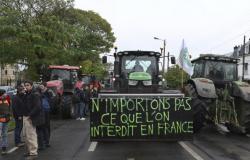Projections for volumes for the 2024 harvest are being refined and forecast a considerable drop, of -23% over one year.
Wine production in 2024 in France is expected to decline by 23% year-on-year, due to “unfavorable weather conditions in all production regions”, according to a new estimate published Friday by the Ministry of Agriculture. As of November 1, the 2024 harvest was estimated at nearly 37 million hectoliters, a volume close to the historically low levels of 2017 and 2021, years also marked by climatic hazards.
17% less than the average of the last five years
Also read
Harvest: in Bordeaux, towards a “historically low” harvest
This represents a decline of 17% compared to the average of the last five years. All types of wine are affected, particularly in Burgundy, Beaujolais and Champagne, as well as wines intended for eaux-de-vie (down 36% after benefiting from an exceptional harvest in 2023). These projections were further revised downwards, since in September the statistics and forecasting services of the ministry predicted a decline of 18% over one year.
The year 2024 was characterized by precipitation from spring until the harvest and health problems which reduced volumes. In many vineyards, flowering took place in cool and humid conditions, leading to coulure (fall of flowers and young berries) as well as millerandage (formation of berries that are too small), recalls the ministry. Added to this are losses due to frost in spring, mildew and hail in summer.
All the regions affected, what are the results?
According to this source, in Champagne, production would be 46% lower than last year and 31% lower than the five-year average, between a lack of sunshine, spring frosts and excess precipitation. Production in Burgundy-Beaujolais as a whole would be 38% lower than the high level of 2023, with mildew causing losses particularly in the Côte d’Or and excessive rainfall in Beaujolais, including during the harvest.
In Alsace, production is expected to fall by 13% due to difficult flowering and attacks of mildew. In Savoie, after frost in spring then mildew in summer, production would drop by 5% over one year (stable over five years). In the Jura, frost and mildew reduce the harvest by 68% compared to the high harvest of 2023.
In the Loire Valley, yields are low for the Muscadet appellation and wine production is expected to drop by 29% over one year, due to mildew and coulure. In the Charentes, where the harvest started early due to bad weather, production is expected to decrease by 37% compared to the record year 2023.
In Bordeaux, between the reduction in viticultural areas, episodes of coulure, millerandage, mildew and hail, the harvest should drop by 12% after a year already in decline in 2023. In the South-West, the harvest should be less than that, already reduced, of 2023 due to coulure, millerandage, mildew, frost and hail.
In Languedoc-Roussillon – the leading French wine-growing region in terms of volume – the harvest would be 9% lower than last year, with in places a recurring drought which has weakened the vines, and elsewhere, mildew, favored by significant rainfall in early summer. In Corsica, drought followed by pest attacks and rot at harvest time would reduce production by 15% compared to 2023, and by 2% compared to the five-year average. In the South-East, millerandage, late frost and mildew mainly affected Provence, and production in the basin contracted by 11% compared to 2023.
This publication comes as representatives of farmers, including wine growers, are preparing to launch a new protest movement to defend their income.






